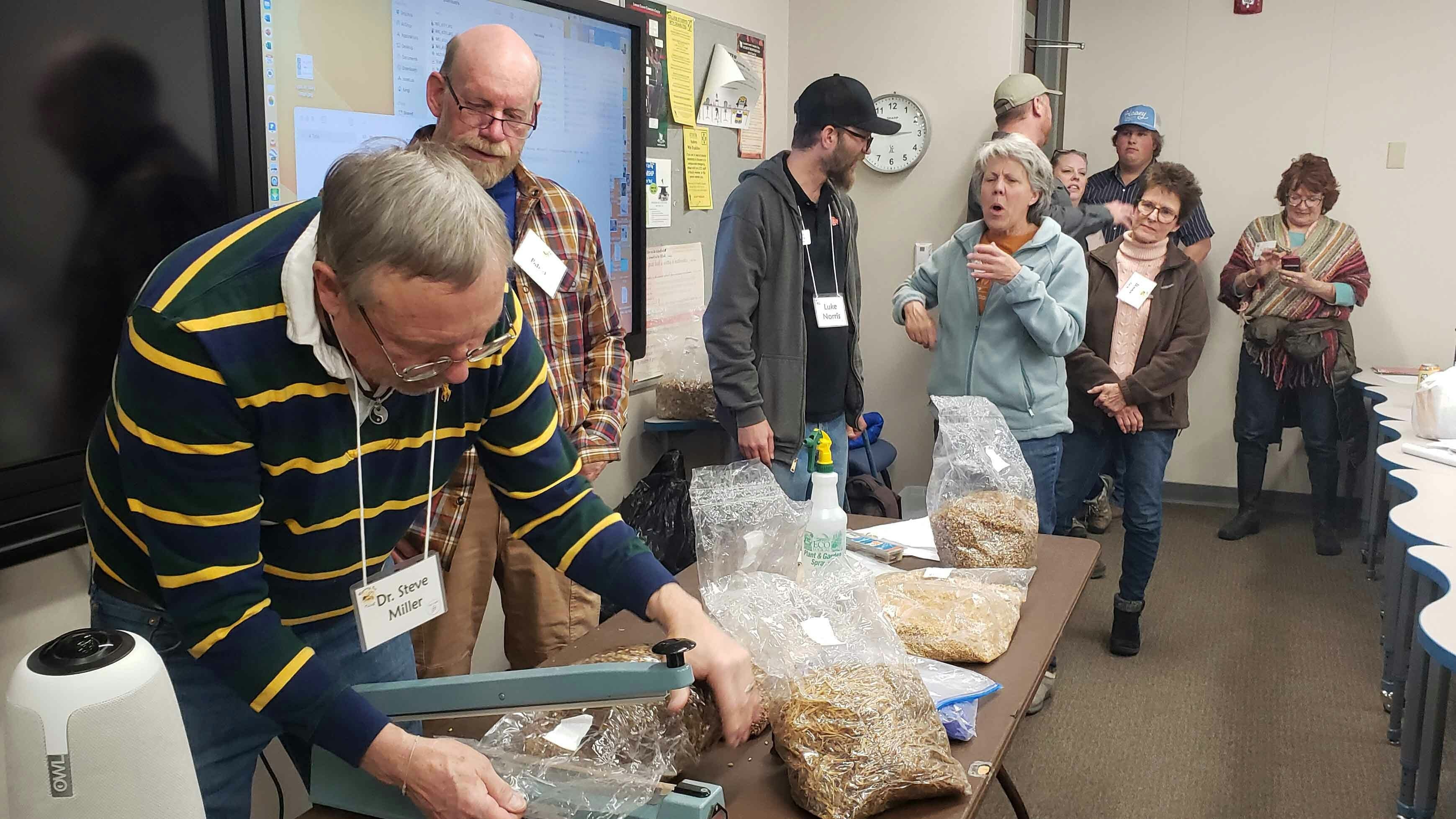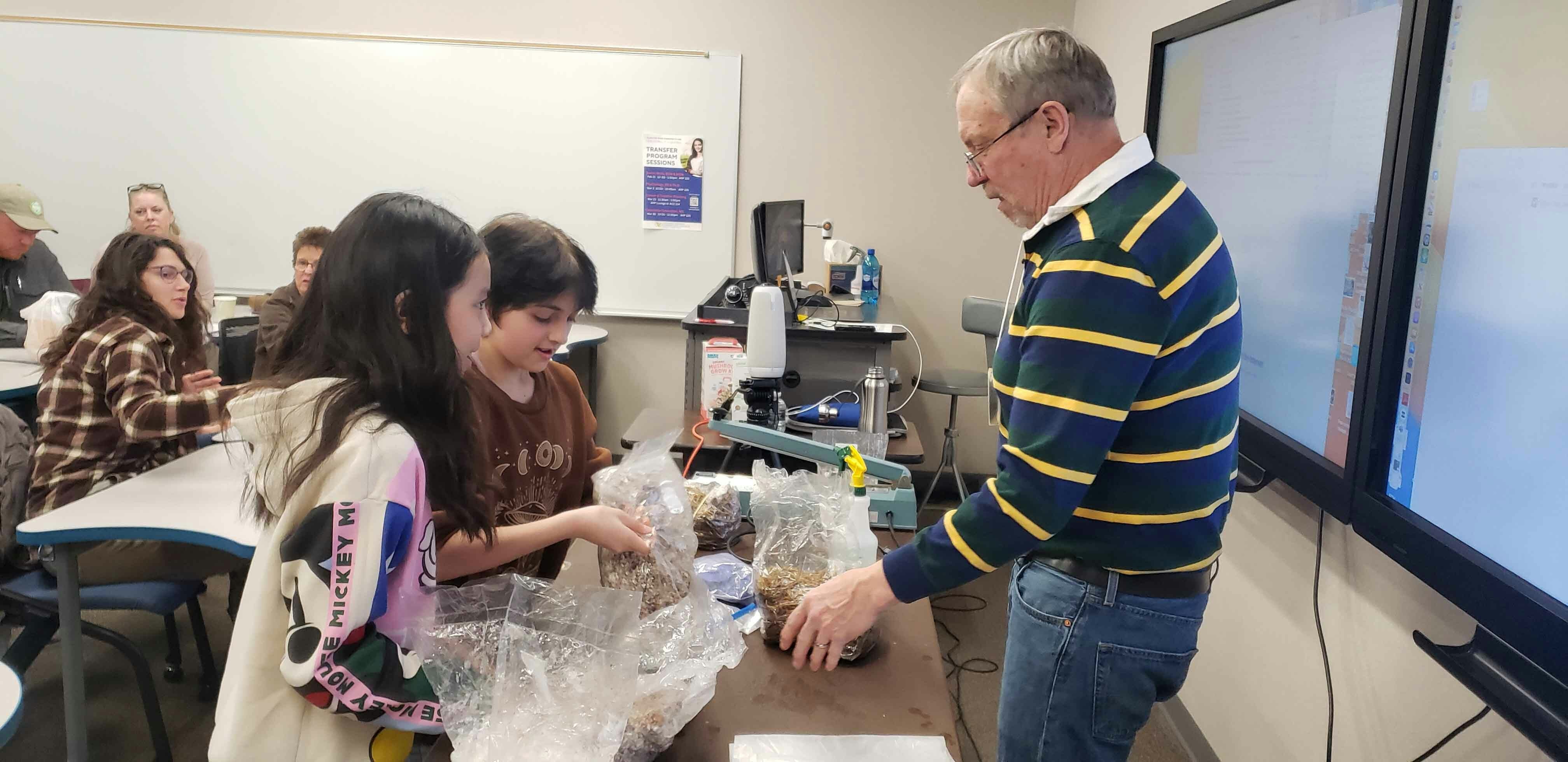People will often say in jest that they are not mushrooms, grown in the dark on manure, but it's not quite true that mushrooms need no light at all, nor will just any mushroom grow on manure.
White button mushrooms and portabellas will grow on manure, but shiitake prefer a sawdust substrate - though University of Wyoming fungi expert Steve Miller once used cottonwood leaves to grow them.
"I collected all the cottonwood leaves from Laramie around my neighborhood and I grew shiitake on them," he told a standing-room-only class that gathered during the Garden to Market Conference in Cheyenne recently. Folks there were interested in learning to grow their own mushrooms at home.
Mushrooms, Miller told them, are an apartment-friendly crop, perfect for farmer's markets. They're also fun science projects for families with young children. They're inexpensive to grow, and it doesn't necessarily require a green thumb.
"The shiitakes grew really well on the leaves," Miller said.
The only problem Miller has had with using leaves from the landscape was pesticides. They are a mushroom killer.
Meanwhile, dim light is actually necessary to help edible mushrooms form the fruiting bodies that ultimately find their way to our dinner plates.
"Light and CO2 levels are two ways that the fungus knows when to release its spores into the environment," Miller told Cowboy State Daily. "An example would be a mushroom developing from the inside of a log. It will make only stem tissue until it reaches the light, then it will make spore-bearing tissue, and disseminate its spores away from the log."
Carbon dioxide also has a limiting effect on spore development as well.
"When the CO2 is high, it means it is in a place where the spores cannot move any distance," Miller explained. "But when the CO2 is low, it means the mushroom is getting fresh air, so it starts to produce spore-bearing tissue."

Something Even Apartment Dwellers Can Grow In Abundance
Miller is all about teaching the finer points of mushroom growing. He sees it as an inexpensive crop that's accessible to just about anyone, even if they live in a tiny apartment.
A crop averaging 6.55 pounds of mushrooms can be grown in a mere square foot of space in a matter of weeks, according to American Mushroom Institute. That suggests an awful lot of mushrooms can be grown on shelves in a space that's no bigger than a linen closet.
"It can be a relatively cheap way to make money at farmer's markets, and it's currently very popular," Miller said. "The substrate for growing mushrooms can be found from a variety of free or nearly free agricultural wastes in Wyoming, as well as other place in the world."
Straw from barley and wheat, leftovers from processing hemp oil or sugar beets, recycled office paper, leaves from the yard, manure from horse, cow or chicken pens, are just a few of the nearly free materials available in Wyoming to grow manure.
"Growing mushrooms can provide important value to struggling agricultural operations that produce these substrates," he added. "Use of these substrates to grow mushrooms is also sustainable."
Mushrooms have great nutrition, Miller added, in addition to being delicious.
"The nutrition of most edible mushrooms compares favorably to most vegetables," he said. "Edible mushrooms have more Vitamin B5, Copper, Vitamin B2, Vitamin B3, and Selenium."
Some mushrooms, especially those grown under light, can also have Vitamin D.

Cost Isn't The Main Barrier
While mushrooms can be inexpensively grown just about anywhere indoors or out, there is one major barrier to more people growing mushrooms whether for home or farmers market.
"It takes time to learn and master the skills of successful mushroom cultivation," he said.
Miller hopes to one day re-establish a class on growing mushrooms at the University of Wyoming. Lack of a functionally appropriate space has hampered efforts to bring the class back, Miller told Cowboy State Daily, but, if the attendance at the recent Garden to Market Conference at Laramie County Community College is any indication, popularity isn't an issue.
Miller's hands-on class, which sent each participant home with their own handmade blue oyster mushroom kit, was standing room only. All ages were represented, too, from young to old.
Miller happily supervised each participant's efforts, after first explaining how to sterilize the mushroom-growing medium - in this case straw - as well as other quirks of mushroom growth that participants needed to know to successfully raise their very own blue oysters.
More Cost Effective than Controlled Environment Agriculture
Much attention has been given to Controlled Environment Agriculture of late, which involves a technology-based approach to farming. They can range from simple shade structures to full greenhouses and indoor vertical farms.
Advanced systems are fully automated with controlled lighting, water, and ventilation, set at parameters that provide optimal growing conditions, while preventing pests and disease.
While these systems are intended to be cost-effective, by delivering high-quality produce closer to consumers using minimal water, Miller believes mushrooms are more cost-effective.
Mushrooms make more sense, Miller believes, because instead of adjusting the environment to the mushroom, growers can simply adjust which mushroom they're choosing to grow to existing, ambient environmental conditions.

Medicinal Mushroom Opportunities
In addition to growing edible mushrooms, many medicinal mushrooms have been identified as well, which Miller believes could create new and lucrative markets for mushroom growers.
"For thousands of years, indigenous people have made extensive use of the biodiversity contained in the forests to meet their health needs," Miller wrote in a recent book chapter about cultivating medicinal mushrooms.
Africa, India, and China all have established medicinal protocols that include many fungi for primary health care needs. Scientists, meanwhile, have identified at least 130 medicinal functions for various mushrooms, including the prevention and treatment of immune disorders.
"It is obvious that medicinal fungi offer effective treatment options for many conditions and diseases currently affecting human populations, and that may be prevalent in underdeveloped areas," Miller added. "Unfortunately, deforestation, over harvesting certain high potency fungal species, as well as politics, conflict, and poverty have undermined the ability of many people to receive even the most basic health care needs."
Mushrooms, including medicinal ones, can be grown with a low-tech approach. Widespread knowledge of how to do this could help increase the availability of fungal-derived medicines that people need, Miller believes.
Box
Miller is hoping those interested in seeing a mushroom class resume at the University of Wyoming will contact the Associate Dean of Agriculture, Life Sciences and Natural Resources to let him know of their interest. His phone number is 307-766-5283 and his email is Means@uwyo.edu.





